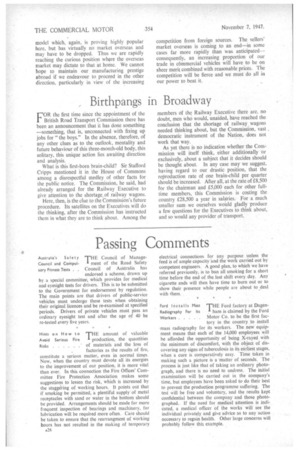Export Targets' Effect on Design
Page 27

Page 28

If you've noticed an error in this article please click here to report it so we can fix it.
THE demand for goods vehicles weighing under 3 tons unladen, so that they come within the present classification of those permitted to travel at 30 m.p.h., may become impossible to meet now that the export targets are to be raised by such high percentages. This type of vehicle introduces one great difference between chassis designed for home use and those for overseas, and there are already too many variations.
With a comparatively small petrol engine, such chassis to carry reasonable loads can be produced fairly easily, but for overseas work they are required to compete with many foreign chassis with larger power units, and it is notable that some important overseas transport authorities still ask for petrol engines, which are considered quite satisfactory up to laden weights of 9 to 10 tons.
This call for bigger engines, however, may mean specialization, and if the number of chassis supplied for home use be considerably reduced it may be necessary, in the interests of production, to drop the smaller units.
Export Influence on Vehicle Weight When it comes to the employment of mediumpowered oil engines in such chassis it is still more difficult to keep within the 3-ton limit. 'lhis trend in itself is a forceful argument in favour of the raising of the general speed limit for commercial vehicles to 30 m.p.h. The home operator may not, in the interests of economy, wish to have a more powerful engine, but, as we have pointed out, this may be forced upon him, and it would he unfair, as well as uneconomic, to compel the speed of such vehicles to be lowered to 20 m.p.h.
The makers, if they studied only their own interests, might think this a good move, as, eventually, they would sell more vehicles to make up for the reduction in transport efficiency; but, from what we know of them, they are far more inclined to take the view that an amendment of the speed limit in the required direction would be in the national interest.
It is in the vital_ interest of operators to remind them that whatever limit of speed be decided upon, the police are preparing to take action, and if vehicles be pinned down to 20 m.p.h. by law, this will be rigorously enforced. Drivers would certainly suffer, for we can see that the prosecutions for speeding would be numerous: At present there is little trapping, and they have become accustomed to something like a free hand in travelling at the speeds they prefer, but all this will go by the board and experience will soon teach them that they will no longer be able to monkey with the law; it will be on their tails and behind the trees or other convenient hiding-places!
No commercial-vehicle driver whom we know has expressed any satisfaction at thern prospect of being rigidly bound to a 20-m.p.h. limit, and we can sympathize with him in this respect. It is a speed with a soporific action; it seems to get one nowhere in a long time. How often one hears a driver say that a little burst of speed will "burn out the carbon and make the old bus pull better." There may be a lot more in this than mere imagination or wishful thinking, for an engine designed to develop its best characteristics in the way of power and economy at a certain number of revolutions per minute does not appear to appreciate long spells of running at much below this figure. It upsets-all calculations as to engine warmth, lubrication, etc Some "Home" Types May Co Reverting to our original point regarding the possible dropping of models, this may also be applied to those of much larger capacity than the "under 3-tonner," where they have been designed primarily for the home market. For example, we know of a 7-ton model which has proved excellent here. It employs a fairly large fbur-cylindered oil engine and was, in this particular instance, designed to run at 20 m.p.h. with maximum economy. For overseas use, however, the vehicle would have to be redesigned with a six-cylindered engine giving far more power, and it may be that it would be found impossible to produce the two models side by side, in which case it would mean that the home buyer would have to accept the more powerful machine, which would not provide the same economy at the low limit or even greater speeds.
The same maker recently produced a new 4-ton A25 model which, again, is proving highly popular here, but has virtually no market overseas and may have to be dropped. Thus we are rapidly reaching the curious position where the overseas market may dictate to that at home. We cannot hope to maintain our manufacturing prestige abroad if we endeavour to proceed in the other direction, particularly in view of the increasing competition from foreign sources. The sellers' market overseas is coming to an end—in some cases far more rapidly than wasanticipated-consequently, an increasing proportion of our trade in commercial vehicles will have to be on sheer merit combined with reasonable prices. The competition will be fierce and we must do all in our power to beat it.




















































































